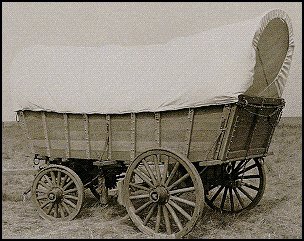| FALLS CITY was STARTING POINT for WAGON TRAIN |
(This article appeared in the Falls City Journal, Wednesday, March 14, 1962)
This page added 06-08-01
Probably few Falls Cityans, who watch the popular Wagon Train series on television, are aware of the fact that at least one wagon train, with a contingent of hopeful Kansas colonists, originated in Falls City, Nebraska. Some of the descendants and relatives of members of that early wagon train still live here (in 1962) and remember something about it.

The history of the wagon train, carrying Sinclair's and George Faulkner, one-time sheriff of Richardson county, and others was retold last fall by the Jetmore Republican, Published in the town of Jetmore, Population 1,028, the County seat of Hodgeman County in west-central Kansas, just north of Dodge City.
The train, containing 20 wagons, was reported by the Jetmore paper as being one of the largest ever to emigrate into that part of Kansas, with colonization in mind. The year was 1879.
Mrs. Belle Mulligan, James Q. Hossack, Mrs. Paul Schulenberg and Mrs. Agnes Messler are grandchildren of James Sinclair, an early-day blacksmith, who listened to the siren call of the free land in western Kansas, pulled up stakes and joined the train. (A part of his family was grown and remained behind, at that time) One of James Sinclair's sons, W. D. Sinclair, eventually became a very large landowner, wheat farmer and grain man. Another relative is Miss Faye Hanna, local school teacher, whose mother was a Faulkner.
Mr. S. Mulligan recalls that the trip, which, now takes about seven hours by car, took the colonists 67 days.
The Journal is indebted, to Mr. and Mrs. Oscar Rhoads for a copy of the newspaper's 5th anniversary account of the Falls City wagon train. They picked up the anniversary edition while they were visiting their son-in-law and daughter, Mr. and Mrs. Harry Leidigh, at nearby Spearville.
George Faulkner was sheriff of Richardson County from 1868 to1873, inclusive. The colonists hired an old scout named Bill Potterton to serve as their guide and wagon master in getting the train through to their destination, a location in northwest Hodgeman County where the government permitted a settler to take up 480 acres of land. The scout and wagon master was to get $25 for the trip and his meals. Each of the wagons was to furnish him his meals in turn and a part of his duties were to go ahead each day and find a suitable camp site for the night.
The train went southwest to Sabetha, traveled west to Seneca, and Marysville along the approximate route of today's Highway 36 and then headed southwest. Earl Pitts, a grandson of George Faulkner, who tells the story of the Falls City wagon train, said that the going was exceptionally slow and on some days the train could not make more than six or eight miles. The over-all distance, from Falls City to the Hodgeman County destination, was about 400 miles.
As Mr. Pitts recalled from the accounts of his elders, there were only three citizens in that section of Hodgeman County, when the Falls City colonists arrived in the fall of 1878.
They left Falls City for Hodgeman County on Mar. 28, 1878, with about 40 head of livestock cattle, extra horses and mules. The train reached Larned, Kas., in May and replenished its supplies there, its last opportunity before reaching its destination.
"The hardships were many but they had their fun, too." Mr. Pitts wrote, "When they camped at night, they had singing and music. Several of the group had violins and other instruments. Mr. Jones (not otherwise identified) was a good violinist. They also had a male quartet composed of John and Charles Faulkner, George Blackburn and Al Prichard."
Swollen rivers held the train up at times and at others, it stopped several days at a time for rest and to replenish its stores. One such stop was at Salina.
The colonists were somewhat disappointed to find that buffalo were no longer plentiful in their new home. "Many had expected to have all the buffalo steaks they could eat," Mr. Pitts wrote, "but the buffalo were gone except for a few old, crippled bulls not fit to eat. However, there were a few antelope and prairie chickens left." "This was the beginning of many more settlers coming from Falls City, Nebraska."
It might be interesting to note what Mr. Pitts gave in explanation for the move from Richardson County, Nebraska, to Hodgeman County, Kansas.
"In Richardson County, Nebraska, all free government land had been homesteaded and deeded. Around Falls City, the County seat, the seasons had been good, the crops excellent and the prices very good for what they had grown. This made it difficult to get a start. No one wanted to sell out unless they could get a fancy price for their holdings."
That old call, "Go West Young Man, Go West," got the better of some of them . . . . .
Back to History of Richardson County GoTo DelC's - Genealogy Site